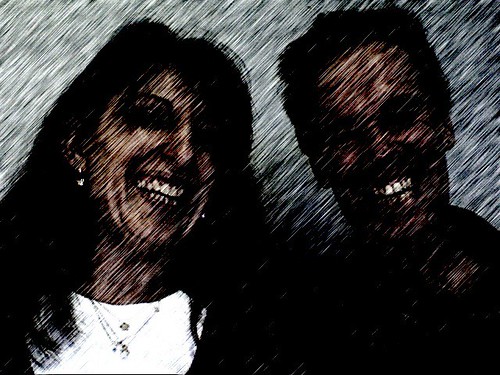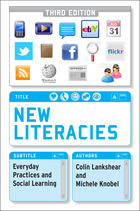Friday, February 08, 2008
Second Video247 Panel: State of the Art
This panel session focussed on a range of applications of DIY media production within diverse settings.
Alexandra Juhasz: YouTube and education
The first speaker, Alexandra Juhasz, spoke about recent work she has been doing with her uni students exploring YouTube as a space for higher forms of learning and academic engagement. I'll be upfront and let you know that the I couldn't quite grasp the point of this presentation because I found her basic assumption -- that YouTube should be a resource for higher learning -- to be misplaced. YouTube has certainly never presented itself as an academic learning resource, so to claim that it isn't seems odd to me (although the twist is in the tail is that at the very end of her presentation, Alexandra ended by saying that through creating their own YouTube videos an their critiques of YouTub content, the group did find YouTube worked to promote "higher learning". You can see some of the videos this group developed here.
Alexandra identified number of binaries that impacted impacted her teaching and her students’ learning within the context of their critique of YouTube content:
• Public/private
• Cyber/real
• Oral/visual culture
• Edutainment/education
• Amateur/expert
• Control/chaos
Her stated goals were to impose control on a chaotic site, to build community and ideas together.
Thenmozhi Soundarajan: Six Years of Media Justice
Thenmozhi opened her presentation with the clip, "Who we be", spoken poetry film about identity and ethnicity made in 2001 (well before accessible video editing software became available).
• Thenmozhi asked the provocative question: "What does media equity look like?" she defined "media justice" as: "our belief that we all have the human right to communicate" targets people who have limited access to the means of media production
• she Spoke about the importance of focussing on access and aesthetics, including teaching DIY movie makers--especially those from marginalised cultural groups--directing processes, for example. In her work, she begins this process with people directing live-action skits. another example of a practical strategy she uses is what she calls "How do we flip the script to tell our stories?". This entails thinking about the frames that currently define your story (e.g., "illegal alien" and deconstructing a range of imposed labels) and redefining them (e.g., unpacking the distinction between "looting" and "salvaging" in reports of Hurricane Katrina’s aftermath).
Sam Gregory
Sam is the program director of "Witness", a non-profit orgnisation that focuses on raising awareness of human rights violations around the world.
• Sam spoke about a new proect that aims at collating witness a commentary videos dealing with human rights violations within a single video hosting and comments site, while at the same time he usefully problematised the project itself by asking: Is smart 'narrowcasting' the right approach for advocacy?"
• Sam himself spearheaded a project that gave out hundreds of video cameras to human rights groups around the world. However, the model itself proved to be ineffective because they hadn’t trained people in how to use the cameras, how to tell video narratives, and so on.
• He also explained that Youtube is not proving to be an effective medium for sharing videos made by human rights groups because it is too dispersed in terms of focus, and comments left by veiwers tend to comprise a lot of "hater" speech, so they’ve set up The Hub as a space for groups to post their human rights violation videos (e.g., actual evidence, interviews with victims/witnesses etc.)
• The Hub (launched December 10, 2007) aims at serving specific needs; in contrast, the torrent of clips available on YouTube is too overwhelming. The most-viewed videos on YouTube are viewed 150 times more than the most popular human rights videos posted to the same site. moreover, the human rights videos that do tend to attract attention on YouTube tend to include violence or torture which risks promoting a narrow view of what comprises human rights violations.
• Human rights videos posted to generalist video hosting sites tend to attract racist comments from a "transitory audience" rather than from an "engaged public"
• The Hub aims at being an ethical alternative to YouTube (e.g., it doesn’t track IP addresses); it values ensuring videos posted to the site easy to download and use in other contexts; it's open source; editorial control is in the hands of the community
• Sam asks:
o "What are the implications of this kind of ubiquity of images for human rights work?" Ironically, he explained, much of the human rights abuse videos are shot by the abusers themselves (i.e., trophy videos, brag videos etc.)
o "How do we emphasize human dignity and protect identity in human rights videos?" (e.g., the Burmese government used activist video footage to track down and kill dissidents). "How do we protect people when we use online video posting to engage public comment?"
o "How does remix come into play in activist videos?" Sam thinks it can be a positive effect because it promotes public engagement. But what happens, he asks, when this remixing itself violates human dignity and rights etc.
o "How do we motivate action?" Sam wants to promote ways of responsibly moving testimony images and clips between and across different contexts, an--particularly within (over)developed countries--generating meaningful texts within contexts that often value irony and humour over everything else.
o One of the problems facing activist video-making is providing access to an audience without a loss of integrity while still appealing to the audience and prompting them to action. This is why storytelling elements need to be taught explicitly. Sam calls for a DIO approach -- "doing it with others" -- and a co-production approach to video-making; and a distributed, network-centric approach (e.g., the MoveOn.org 30-second anti-Bush ads).
Juan Davis
Juan Davis is a "web producer" involved at present in developing programs broadcast on television and online (hope I have that correct!). He is currently working for KCET TV, a Los Angeles based public television station. Juan himself explains that he was invited to work at USC producing local content in order to reach an 18-35 demographic, in particular. at present he is producing a series called, ""Sustaining LA"", which includes shows like "Fallen Fruit", which documents fruit trees throughout Los Angeles. Other projects include a series of films about Malibu beaches and finding public spaces on the beach, and "Departures". Each show in this series looks at one block in a neighbourhood in term of its rich history and humanity to trump the bad press Los Angeles often gets. The series is accompanied by a blog and a 360 degrees navigable panorama of each neighbourhood featured in the series. In this set of shows, Juan explained, they deliberately avoided historians and academics in putting each show together, and simply talked to people they met while walking around a block and recorded what they had to say about themselves and about their neighbourhood. Juan hopes that in 4 years, they’ll have hundreds of rich portraits of Angelenos.
One of the really ground-breaking things about this particular website companion to the television series is that Juan and his team have written instructions for how to build your own version of their website (including for the panorama and embedding the video portraits etc.). They are currently working with a Los Angeles highschool to create their own community version, and then this will be given to the KCET TV station to host on their website.
Henry Jenkins
Henry calls for more exploration of what DIY media can do, as well as what needs to change in order to enable us to do more.
• He is currently thinking more about the "you" in YouTube these days. In English, this pronoun is both singular and plural. He asks: "Is this a space of individualism and narcissism, or is it a space around which we can mobilize valuable stuff?"
• For Henry, YouTube is the intersection of many participatory cultures, each of which has a much longer history than YouTube (e.g., citizen media, fan culture, skateboard culture)
• New forms of mixing popular culture and activism are arising through DIY media. For example, the character and films featuring "Mr Bill" grew out of a Saturday Night Live series of home video competitions. Most recently, the "Mr Bill" videos have started to focus more on environmental issues and to embody environmental activism. Similarly, a popular set of videos on YouTube, Billiam the Snowman, which were made as part of CNN's YouTube debate series. One of these clips was selected to play on CNN during their televised debates, but then-presedential hopeful, Mitt Romni refused to respond to the question asked by Billiam the Snowman or to even talk about this popular clip. The Snowman video-makers went on to create a range of videos critiquing Romni's campaign. Thus, Henry argues, Youtube does develop conversation, it just isn't necessarily--or even often--confined to the YouTube comments posts. Instead, this dialogue takes place across the internet, via the blogosphere etc. It also enables the flow of media that can be re-localized within blog contexts etc.
• Henry also spoke of a "participation gap": that is, disparate access to social skills and cultural competencies that enable us to feel competent to pariticpate in something like YouTube. He asked: "Why is it that some sections of the community participate and others don’t?"(e.g., on YouTube the most popular videos tend to be made by white, middle class males). How can minority perspectives been made more visible on YouTube? Henry explained that "hater" talk in YouTube comment posts often belittles people who choose to challenge anti-racist messages. However, on th other hand, Henry also asked whether if we create exclusive enclaves like "The Hub" then is it only preaching to the choir? there is a real paradox regarding how we mobilize ideas within or via YouTube.
• Henry mentioned an interesting study by Justine Purcell who analyzed current politician's talk posted online (e.g., text of speeches, videos). She found that if you look at older politicians, the most used pronoun in their texts is "I" and in younger politicos, the pronoun is "we"
• Henry himself calls for "WeTube" rather than "YouTube"
Labels: video247








